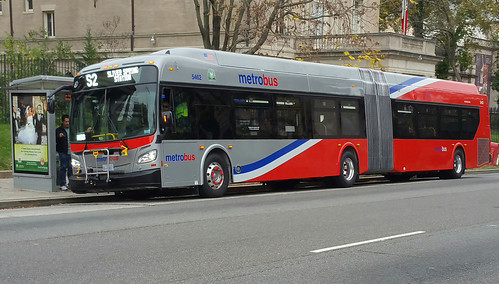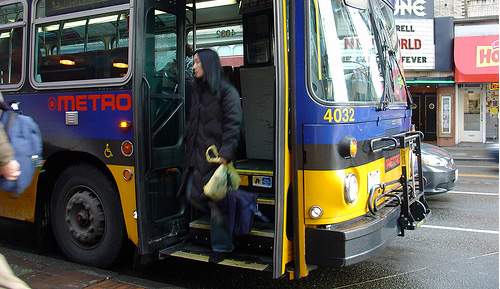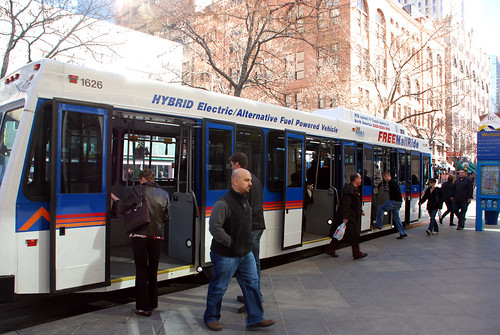You might someday ride a Circulator bus from NoMa to Starburst. Or maybe from NoMa to U Street, Columbia Heights, or Logan Circle. DDOT is doing a study to decide.

NoMa Circulator options. Image by DDOT.
NoMa as transit hub
NoMa is one of DC’s fastest-growing neighborhoods. With 40, 000 workers, 18, 000 residents, and huge new developments coming soon, it’s fast becoming an extension of downtown, and a natural hub of activity.
But aside from its crucial Red Line Metrorail station, NoMa is a transit afterthought. While most Metro stations double as bus hubs, no public bus lines have stops directly at NoMa Metro.
WMATA’s important 90s series Metrobuses pass nearby on Florida Avenue, and the X3, 80, P6, and D4 all skirt the edges.
But that’s nothing like the bus service in downtown, or other downtown-adjacent neighborhoods. It’s too paltry to do much to help residents of nearby neighborhoods like Trinidad or Truxton Circle reach NoMa.
If NoMa is to become the great nerve center of Northeast DC, it’s simply going to need better transit connections to the rest of Northeast.
Enter DC Circulator
With bus service every 10 minutes all day, DC Circulator certainly qualifies as a good bus. Making NoMa the focus of a new Circulator line will absolutely be a great addition.
As always, the devil is in the details.
DDOT planners are considering 5 potential routes, going in wildly different directions.
Some options eschew Northeast and connect only to Northwest destinations like Columbia Heights, U Street, or Logan Circle. Other options have a leg extending east on Florida Avenue as far as Starburst and Benning Road.
Further connections to Northeast, like extending the line up Bladensburg Road, aren’t on the table.
Theoretically DDOT need not select only one option. They could pick and choose the best aspects from multiple options, and stitch them together for a final hybrid.
Proposed routes are too complex
One serious concern with all five routes is that they’re too complex.
The most successful bus lines are usually simple, direct, and consistent. Straight lines are easier for riders to understand and remember, and reach destinations faster than squiggly circuitous routes like these NoMa proposals.
This graphic comparing the most and least successful bus lines in Vancouver nicely illustrates the issue:

Image from Vancouver TransLink.
Buses in DC absolutely follow the same pattern. The highest-ridership lines in the city are virtually all straight and direct, like on 16th Street and Georgia Avenue. Meanwhile, complex, circuitous routes like the W2 don’t get many riders, despite connecting multiple destinations with a lot of potential riders.
The problem is M Street
Theoretically M Street NE is the natural spot for an east-west bus through NoMa. It offers a straight shot through the underpass below the railroad tracks. The southern entrance to NoMa Metro spills out onto it, and M’s corner with First Street NE is the center of the neighborhood.

M Street NE. Photo by Ted Eytan on Flickr.
Unfortunately, running a bus on M Street is difficult. Although it’s two-way through the heart of NoMa, it switches to one-way on both the east and west sides. Unless DDOT reconfigures M Street to be two-way (a prospect that might wipe out the nice protected bike lane), there is simply no east-west line through NoMa that’s both straight and provides a direct Metrorail connection.
Complexity is, unfortunately, probably mandatory.
But still, some of DDOT’s alternatives minimize complexity, while others are needlessly circuitous. That New Jersey Avenue option is bonkers. Four blocks is too far to separate one-way pairs.
Tell DDOT what you think
DDOT will be hosting a series of public meetings this month to discuss this proposal. You can weigh in at sessions on November 10, 12, 15, 17, or 19.
You can also comment online, via DDOT’s NoMa Circulator survey.
 Comment on this at the version cross-posted to Greater Greater Washington.
Comment on this at the version cross-posted to Greater Greater Washington.
Average Rating: 4.5 out of 5 based on 238 user reviews.





















